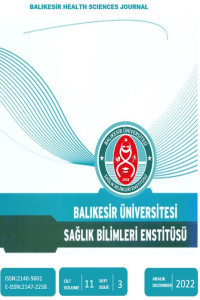BİR AİLEDEKİ KAMPTODAKTİLİ VE KİRNER DEFORMİTESİ
Kirner deformitesi ve kamptodaktili elin nadir görülen konjenital deformiteleridir ve genellikle bağımsız anomaliler olarak görülmektedir. Kirner deformitesi 5.parmak parmak distal falanksının değişik derecelerde palmar ve radial deviasyonu ile karakterizedir ve distal interfalangeal eklemde şişlik ve 5. parmak tırnağında dismorfik değişikliklerle birlikte görülür. Kamptodaktili bir parmak deformitesidir ve bir ya da birçok parmağın proksimal interfalangeal ekleminin travma olmaksızın fleksiyon kontraktürü ve buna bağlı etkilenen parmaklarda volar eğim ile karakterizedir. Tüm parmaklar etkilenebilmesine rağmen en sık 5. parmak etkilenir. Bu iki hastalığın kombinasyonuna sahip bir aile daha önce rapor edilmedi. Bu yazımızda kirner deformitesi ve kamptodaktili’nin ortak bir genetik faktöre sahip olabileceği ön görülen bir aile sunuduk.
Anahtar Kelimeler:
Kamptodaktili, Kirner deformitesi
CAMPTODACTYLY AND KIRNER’S DEFORMITY IN ONE FAMILY
Kirner’s deformity and camptodactyly are rare congenital hand deformities usually occurring independently. Kirner’s deformity is characterized by palmar and radial deviation of the distal phalanx of the little finger with a varying degree of rotation and a small, dysmorphic watch-glass nail associated with swelling of the distal interphalangeal joint. Camptodactyly is a non-traumatic flexion contracture of the proximal interphalangeal joints of one or more fingers, resulting in a permanent volar inclination of the affected digits. Little finger is the most frequently affected one, but additional fingers may also be involved. The combination of these two entities in a family had not been previously reported. The family presented here suggests that Kirner’s deformity and camptodactyly may have a common genetic factor.
Keywords:
Kamptodactyly, Kirner’s deformity,
___
- 1. Song WC, Koh KS. Kirner’s deformity: progressiveness and classification (Surg Radiol Anat) 2005; 27:459-62
- 2. Scott CE, Engber W. Kirner’s deformity: A case report and review (Iowa Orthop J) 1996; 16:167-9
- 3. Flatt AE. The troubles with pinkies (BUMC Proceedings) 2005; 18:341-4
- 4. Beluffi G, Fiori P. Clinical and radiological findings in Kirner’s deformity. A report of nine cases. (Radiol Med) 2006; 111:432-9
- 5. Ty JM, James MA. Failure of Differentiation: Part II (Arthrogryposis, Camptodactyly, Clinodactyly, Madelung Deformity, Trigger Finger and Trigger Thumb). Hand Clinic 25,2009:195-213. Elsevier Inc.
- 6. Malik S, Afzal M, Gul S, Wahab A, Ahmad M. Autosomal Dominant Syndrome of Camptodactyly, Clinodactyly, Syndactyly and Bifid Toes (Am J Med Genet) 2010; 152:2313-7.
- 7. Malik S, Schott J, Schiller J, Junge A, Baum E, Koch MC. Fifth finger camptodactyly maps to chromosome 3q11.2-q13.12 in a large German kindred (Eur J Hum Genet) 2008; 16:265-9.
- 8. David TJ, Burwood RL. The nature and inheritance of Kirner’s deformity (J Med Genet) 1972; 9:430-3.
- 9. Damen A, Lei B, Nicolai JPA. Kirner’s deformity and clinodactyly in one family (Eur J Plas Surg) 2000; 23:235-7.
- 10. Kaufmann HJ, Taillard WF. Bilateral incurving of the terminal phalanges of the fifth fingers (Am J Roentgenol) 1961; 86:490
- ISSN: 2146-9601
- Yayın Aralığı: Yılda 3 Sayı
- Başlangıç: 2012
- Yayıncı: Balıkesir Üniversitesi
Sayıdaki Diğer Makaleler
EBELİK ÖĞRENCİLERİNİN ELEŞTİREL DÜŞÜNME DÜZEYLERİ VE ETKİLEYEN FAKTÖRLER
Meltem AYDIN, Mine YURDAKUL, Semra ERDOĞAN
Ceylan Çağıl YETİŞ, Çiğdem KÜÇÜKEŞMEN
BİR AİLEDEKİ KAMPTODAKTİLİ VE KİRNER DEFORMİTESİ
Mehmet ERDURAN, Jülide ALTINIŞIK, Gökhan MERİÇ, Ali Engin ULUSAL, Devrim AKSEKİ
Semra KOCAÖZ, Sibel PEKSOY, Cem Somer ATABEKOĞLU
PERİODONTAL OLARAK HIZLANDIRILMIŞ OSTEOJENİK ORTODONTİ: BİR LİTERATÜR DERLEMESİ
